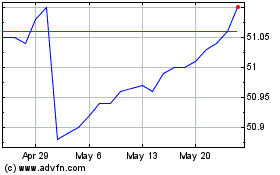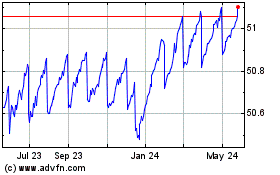Do You Need A Floating Rate Bond ETF? - Top Yielding ETFs
19 December 2011 - 10:01PM
Zacks
With the rapid expansion of the ETF industry, products have
cropped up in a variety of sectors that can give investors exposure
to new asset classes. One such space that has seen a great deal of
interest from some is in the bond space with floating rate
securities. These funds track bonds that do not pay out a set rate
to investors but instead have variable rates that are often tied to
an underlying index such as LIBOR. As a result, bonds that employ
this approach can have different yield rates than their fixed rate
cousins, potentially giving them a unique risk/reward than their
more ubiquitous counterparts (see Top Three High Yield Bond
ETFs).
This could be important given the state of interest rates and
the direction that they will have to go in years ahead. With the
benchmark rate at 0.25% in the U.S., many feel that a normalization
of interest rates will have to take place in the near future,
potentially crushing the long-term bull market in bonds in the
process. However, for investors who have floating rate securities,
the blow is likely to be much less severe. This is because floating
rate securities have a far lower interest rate sensitivity than
their fixed rate brethren, making them ideal choices in rising
interest environments.
Downsides of floating rate bond ETFs
While there may be several positives for this corner of the
market, investors should realize that ‘floaters’ aren’t the be all
end all in the bond space. First, it is important to remember that
we are still in a low interest rate environment and that higher
rates may not be coming down the pike for several years. This could
keep bonds that pay out a variable rate depressed in yield terms
when compared to their fixed rate counterparts for the foreseeable
future, taking away one of the key selling points for the product
class. Furthermore, because floaters have less of a demand from the
general investing public, there are less of these bonds in the
market place suggesting that any fund tracking a basket of these
securities will only have but a handful of different companies. If
that wasn’t bad enough, most securities that issue this type of
bonds are financials, meaning that the product will likely see
heavy concentrations in that particular sector over the long haul
(Can You Fight Inflation With This Real Return ETF?).
Yet despite these short-term negatives, a case for floating rate
bonds over the long term can still be made. Most investors are
intensely concentrated in U.S. government debt and with yields at
historic lows, a reversal seems poised to strike the market at some
point in the future. So while in the near-term floating rate bonds
may underperform similar fixed securities, they could make for a
nice compliment to fixed rate-heavy portfolios for investors with
more than a few years until retirement. For these investors, any of
the following three ETFs could make for excellent choices:
iShares Floating Rate Note Fund (FLOT)
This relatively new fund tracks the Barclays Capital US Floating
Rate Note Less Than Five Years Index which gives investors exposure
to a basket of bond securities that have floating rates. The total
portfolio consists of 133 securities but close to 53% of the assets
go towards financials. The fund does have a pretty low expense
ratio, charging investors 20 basis points a year, a figure that is
more than made up for by the fund’s 1.7% 30 Day SEC Yield. In terms
of performance, the product has lost about 2.3% since inception
although it has stabilized in recent weeks (read Go Local With
Emerging Market Bond ETFs).
Market Vectors Investment Grade Floating Rate Bond Fund
(FLTR)
The oldest product in the floating rate ETF space is this fund
from Van Eck. The fund seeks to replicate the Market Vectors
Investment Grade Floating Rate Index which is a benchmark that
consists of U.S. dollar-denominated floating rate notes issued by
corporate issuers and rated investment grade by at least one of the
three major rating agencies. In terms of holdings, the fund has
just 23 securities in its basket putting close to one-fourth of the
total in bonds from Credit Suisse and Citigroup. While the product
does beat out FLOT in terms of expenses by a basis point, its yield
is far worse coming in at 1.1% when measured by the 30 Day SEC
yield metric. The product has also underperformed on the capital
appreciation front as well as this floating rate ETF has lost about
7% in the past six months (see Australia Bond ETF
Showdown).
Barclays Capital Investment Grade Floating Rate SPDR
(FLRN)
The newest fund on the list, FLRN debuted at the end of November
giving investors a very short window into its performance history.
Yet, with that being said, FLRN does track a similar index to FLOT
suggesting that the performance could be near what that security
has produced. Investors should note, however, that there are a few
key differences between the two. First, FLRN only holds about 50
securities in its basket while charging an expense ratio of just
0.15% a year, putting it lower than FLOT for both. Fortunately,
FLRN does beat out FLOT in terms of yield, as the fund pays out
close to 2% a year, thanks to its heavier focus on securities that
are a few years away from maturity and (as opposed to the other
products which have a slightly greater tilt towards short-terms
bonds).
Want the latest recommendations from Zacks Investment Research?
Today, you can download 7 Best Stocks for the Next 30
Days. Click to get this free report >>
Zacks Investment Research
Want the latest recommendations from Zacks Investment Research?
Today, you can download 7 Best Stocks for the Next 30 Days. Click
to get this free report
iShares Floating Rate Bo... (AMEX:FLOT)
Historical Stock Chart
From Dec 2024 to Jan 2025

iShares Floating Rate Bo... (AMEX:FLOT)
Historical Stock Chart
From Jan 2024 to Jan 2025
